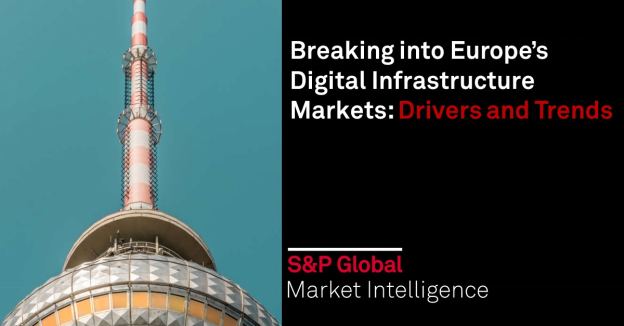
First blog in a three-part series – Datacenters
The digital world has become critical to daily life, as the COVID-19 pandemic proved. Driving a digital transition requires investment in infrastructure – data centers, fiber networks and wireless communication towers that can support data growth and connectivity needs by improving network density, speeds and reliability.
Data centers serve a variety of functions and are essential for housing both edge and cloud workloads. Wireless communication towers are the last mile for all mobile devices and serve as the main connection hub for 5G, fixed wireless and edge computing.
The first of this three-part blog series, based on our recent webinar, highlights key contributions to the development of Europe's digital infrastructure.
Data center developments in Europe
- Europe is growing faster than North America, but not as fast as the Asia Pacific region. 451 Research, the technology research arm of S&P Global Market Intelligence, expects European data center activity to grow by approximately 9% CAGR between 2021 and 2026. While working from home has pushed digitization forward, this growth has always been expected due to the continued demand from hyperscalers in the region.
- Frankfurt, London, Amsterdam and Paris (the FLAP markets) are the top markets in Europe. There are currently about 1,700 mti-tenant data center providers across Europe, and they offer a total supply of approximately 33 million square feet. These four cities represent Europe’s top fee data center markets and the surge is explained by a combination of more enterprise data center capacity being taken, while hyperscale and cloud continue to grow.
- Real estate investment trusts make up more than 25% of the market share. This includes Digital Realty, Equinix and NTT Global Data Centers that will continue to hold large shares in Europe given planned investments over the next several years.
- London remains one of the most important global data center markets. It's the third largest colocation market in the world in terms of megawatts, behind Northern Virginia and Beijing. It’s operating at more than 80% utilization, which is typical of the FLAP markets, where average utilization rates have risen in recent years.
- The interconnection of network, services and cloud locally and internationally is what makes London a key hub for data center services. The city is considered to be a landing point from which to deliver services to the rest of Europe, and it offers a favorable business environment, particarly for U.S. organizations. Despite market challenges, such as obtaining power and land, supply in London has continued to grow with over 770,000 square feet in use, plus 134 megawatts projected to come online by the end of this year.
- London is one of the most technologically advanced markets in Europe when it comes to cloud and new technologies. The strong take-up of AI and data analytics, as well as the growing use of IoT services, has paved the way for an increase in demand for higher-density data center space.
- The Docklands, Central London and the M25 (including Slough) make up today’s London metro market. Traffic between data centers is also growing, and more providers are adding interconnect services across metro Ethernet routes, increasing the appeal of outer-London locations. These outer locations support much larger campus builds. The sites were often previously used by the commercial industry and tend to sit along highly connected fiber or power corridors.
- Subsea connectivity has rested in the rise of locations such as Marseille, Bordeaux and Milan. Subsea connectivity has been vital to the growth of these developing markets, since they not only bring content closer to consumers, but also help to bring down costs and increase overall network efficiency thanks to reduced latency; a key factor when considering the increase in supply chain costs and importance of efficiency in trying to achieve sustainability goals.
Tower developments
- Much of the passive infrastructure in Europe has been sold off. This leaves operators and tower companies to pursue the next phase of opportunity in active infrastructure, such as the radio access network and edge. All this comes back to the expected growth of data use.
- Operators will continue to roll out new towers to cover white spots and holes in the network. This will support the growing bandwidth needs in cities, plus 5G and existing technologies. Looking at the level of activity in tower sales across the globe, there were 173 deals in the last decade pre-2020. Deal activity was concentrated in the Americas and Europe, where values were also higher. This wasn’t surprising given the value of real estate, for instance.
Edge computing
- Edge reduces 5G latency by adding service at the base of towers. That brings the cloud to just several yards below the antenna, which helps operators achieve lower transport costs. Enterprise private 5G networks require real-time processing, and many traditional towers now have room to spare at the bottom of the actual structure to add edge server fridges. Carrier-neutral facilities are complementary to the build out of edge.
- The three largest tower companies in the U.S. have set the tone for the industry. One example, American Tower, sees the hub and spoke model being attractive as edge evolves. Existing tower sites can serve as locations for edge data facilities, and these connect back to core data centers and major metros. Combining its differentiated data center portfolio, communication service provider elements and network operator relationships with the distributed U.S. macro tower portfolio and long-standing MVNO partnerships will significantly enhance the opportunity to create value as the edge evolves.
- All this digital infrastructure ties into one another. Data centers, tower sites and needed fiber and power supplies are critical and are becoming increasingly intertwined.
To learn more about how our Media and Telecommunications solutions can help you stay ahead of the curve, click here.
Listen on demand to the full webinar, Breaking into Europe’s Digital Infrastructure Markets: Drivers & Trends.
